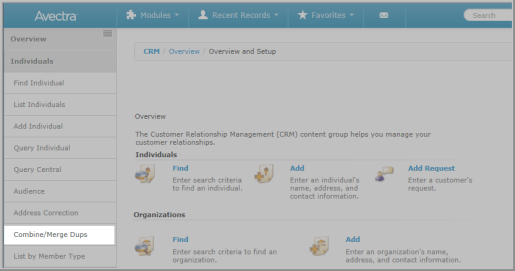

Combine and Merge duplicate Records
The Combine/Merge Duplicate records feature ("Combine/Merge Dups") allows you identify and merge duplicate individual or organization information into one master record.
The Combine/Merge Dups functionality provides a way to:
Note: The process for merging duplicate Individual and Organization records is the SAME.
To Search for Duplicate Records:
Note: By default, individuals are listed in alphabetical order by the first column in the list, which is the individuals' last names. If you would like the sort order to be changed, contact your administrator. Administrators, see Technical Information for specific instructions.
To Select the Duplicate Records:
To Select the Master Record:
To Select and Merge Specific Data Into the Master Record:
Note: Do not close the browser before the processing is done or the merge will be lost.
The netFORUM Combine/Merge feature does not have a way to un-merge merged records. It would be very difficult to make this happen because when records are merged, some of the records from the duplicate customer are deleted outright, some are hidden, and others are transferred to the "surviving" customer. To put all of this back together again pre-merge would be difficult, and the deleted records are unrecoverable.
One partial solution is this: assuming you chose the "hide" option for the "duplicate" customer (rather than "delete"), this customer is now hidden. You could unhide that customer which will essentially bring that customer back. Any related records from that customer that were deleted or transferred, however, would not be recoverable. For example, you might need to re-add committee assignments, memberships, etc. The main value of this approach is that the "duplicate" customer would still keep their original Customer ID if that's important to you.
The Combine/Merge tool does not identify duplicates, it only merges records that you have already determined to be a duplicate. The Individual Duplicate Check Report can be used to help identify duplicates. This report provides a list of potential duplicate individuals, based on several different duplicate-matching algorithms that you can specify in a run-time parameter.
Q. I get this message - DELETE statement conflicted with COLUMN REFERENCE followed by a database table name and other information. Example:
A. The Combine Merge Process attempts to delete certain records of the record you want to drop. In the course of doing so, it is possible that certain dependent records could become "orphaned". For example, if you are attempting to merge two organizations, and one of the organizations has relationships with individuals, then it is not possible to delete that organization. The enforcement mechanism is done with database foreign key constraints, which enforce referential integrity in a database.
In order to resolve this issue, go to the record you want to delete and manually move the dependent records.
In the example in the above screen shot, the record being deleted is a Customer record. But based on the column adr_cst_key_owner, the organization has an "owned" or "linked" address .
Q. How does this feature know which data to use?
A. See Dedup Table. Dedup Tables list which tables should be updated when merging.
Q. How do I adjust the column order, and therefore sort order in the Find Individuals page of the Combine/Merge Duplicate Records process?
A. First, you must have administrative rights in iWeb. With administrative rights, go to Toolkit > Tables List and edit the list table definition for co_individual. Go to the list columns that will appear in list results child form. Select or add any of the columns containing the following types of information and move the selected column to the top of the list:
The Combine/Merge Duplicate Records page sorts by the contents of the column at the top of the list.
Caution! Changing the setting for co_individual changes the column order in any pages that list individuals. The sort order is only affected by this change if there is no other way to set sort order on the page.
Q. What happens if two organizations are merged and each has custom demographics?
A. The surviving organization keeps its demographics and the one that gets hidden or deleted will lose those demographics. It's not possible to merge the two sets of demographics as they might be in conflict with each other.